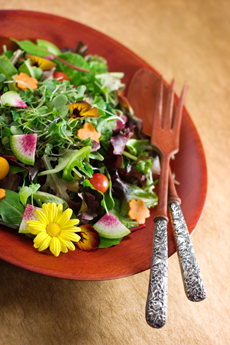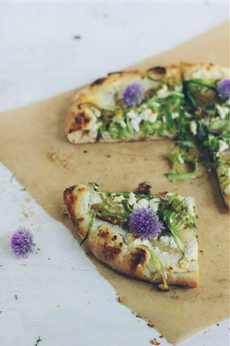TIP OF THE DAY: Celebrate Summer With Edible Flowers

For a special touch, garnish your |
Flowers have been eaten since the earliest times, when anything that could be eaten, was. The first recorded mention of edible flowers dates to 140 B.C.E. In modern times, Asian, East Indian, European and Middle Eastern cuisines remain flower-friendly. If eating flowers sounds strange concept, remember that lavender—used in everything from ice cream and syrup to scones and herbal teas—and candied violets are popular accents in our own cuisine. Many liqueurs are based on flowers. Rose petals, very popular in Middle East cuisines for millennia, can be found in the U.S. in preserves, confections and beverages, and of course, to decorate wedding cakes, cupcakes and other desserts. In addition to eating sunflower seeds, try the petals. They were eaten by the early settlers in America. The violet was eaten in Roman times and was the rage during the Victorian era. You can still buy Choward’s Violet Candy and candied violets. When squash was cultivated, the long blossoms were stuffed and cooked before the vegetable matured. Stuffed and fried in light batter or cornmeal, they are a seasonal delicacy served in fine restaurants. |
|
|
USING EDIBLE FLOWERS Summer is an ideal time to add edible flowers to your recipes. They speak of the season, and provide color and beauty. If you see edible flowers in your specialty produce market or farmers market, pick up a container and have fun with them, in everything from salads and pastas to desserts. Use them fresh, before they wilt; but if you need to store them for a day in the fridge, place them between moist paper towels and then wrap in plastic. When ready to use, rinse each flower gently with water, and carefully blot it dry. |
||
|
Two caveats: Not all flowers are edible—or tasty. Like mushrooms, some are poisonous (including, but not limited to, daffodil, daphne, foxglove and hyacinth). And the edible varieties must be grown without pesticides. Assume that any flower from a florist, nursery or garden center has been treated with pesticides, as well as those in public grounds and roadsides. You can only use organically grown flowers (without chemical pesticides/herbicides). Not all flowers are edible (or tasty), but there’s quite a variety to choose from. Food-friendly flowers include: |
 Caramelized onion flatbread with chive blossoms. Photo courtesy ArtisanBreadInFive.com. |
|
|
As with most plants, flowers are rich in nutrients. Dandelions are rich in flavonoids (powerful antioxidants), and have times the beta carotene of broccoli, along with cryptoxanthin, folic acid, lutein, niacin, pyroxidine, riboflavin, vitamins E and C and zeaxanthin. See our article on edible flowers for more ideas. Two books, The Edible Flower Garden and Edible Flowers, are helpful guides to growing your own and include recipes).
|
||


